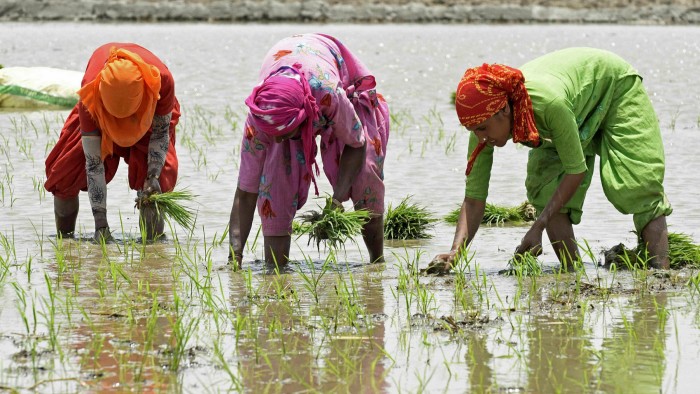ETF strategies for food insecurity offer divergent approaches

Simply sign up to the Exchange traded funds myFT Digest -- delivered directly to your inbox.
Latest news on ETFs
Visit our ETF Hub to find out more and to explore our in-depth data and comparison tools
Dire forecasts of worsening food insecurity present opportunities and potential ethical problems for exchange traded fund investors who want to gain exposure to food, food production and agriculture.
A traditional way to invest in the sector has really paid off this year. The Teucrium Wheat Fund (WEAT), which invests in futures contracts, delivered returns of more than 48 per cent in the year to June 13, compared to -21 per cent for the $361bn SPDR S&P 500 ETF Trust, the largest ETF in the world.
But WEAT comes not only with the risk of exposure to an often volatile futures market and possible regulatory restraints on its sale and distribution, it also raises ethical questions. Although disputed by many academics, there remain fears that speculative investment in the futures market could drive up prices in the spot market and worsen global food insecurity.
“People could be asking themselves: ‘should we be profiting when there is going to be a shortage of food?’,” said Nikolai Roussanov, professor of finance at the University of Pennsylvania’s Wharton School of business. However, on the question of whether futures market pricing could spill over to the spot, he said: “In academic circles, it’s still not a settled question.”
Greg Davies, head of behavioural finance at Oxford Risk, agreed. “On being complicit in driving prices higher . . . for the same reasons I’m sceptical about investors doing much real good through ethical ETF investing I suspect it’s also unlikely ETFs are doing much active harm,” he said.
But for ETF investors who would nonetheless prefer to steer clear there are a handful of other ways to gain exposure to food and the food industry.
Kenneth Lamont, senior fund analyst for passive strategies at Morningstar, said outside China, home to the largest food ETF, there are just three that focus on the industry: the Europe-listed Rize Sustainable Future of Food Ucits ETF (FOOD), the VanEck Future of Food ETF (YUMY) and the Global X Ag Tech & Global Food Innovation ETF (KROP). Total assets in food ETFs globally at the end of first quarter were $1.8bn, according to Morningstar.
All three have lost more than 20 per cent of their value since the start of the year, TrackInsight data show.
“This is not a fund designed to gain exposure to food price inflation,” Rahul Bhushan, co-founder of Rize ETF, said of its FOOD vehicle.
“This year is actually a case in point. While many staple food stocks have rallied hard in the wake of food price inflation, our ETF has experienced negative returns,” Bhushan added, pointing out that the ETF was designed to focus on key areas of innovation that could deliver a sustainable food system and that all innovation stocks have been hit heavily this year.
He argued that transitioning to a more resilient food production system would take many years, and would require decentralisation of agricultural production, ensuring fertiliser was synthesised closer to farmers and promoting a move towards a more plant-based diet.
In the short term, however, Bhushan said he feared that future food price insecurity was not all priced in. “Unfortunately we do believe more negative news is on the horizon,” he said.
Shawn Reynolds, portfolio manager for the natural resources equity strategies team at VanEck, agreed.
“I think this story has not been entirely told,” Reynolds said. “It’s not entirely due to the Russian invasion of Ukraine. A lot of food prices were starting to move before the invasion.”
He pointed to global trends such as the migration from rural locations to urban centres and global growth of the middle class, which were also driving up the price of food.
Reynolds said future food security was one of the concepts that was embedded in YUMY.
Investors who decide to invest in the future of food might have a long wait before they see returns on their investment.
In the short term it might even be wise to think of the political and social implications of worsening food insecurity.
“The truth is we get a very narrow view from the west of the true extent of today’s global food crisis. The inconvenient truth is that many emerging markets face pretty ugly realities,” said Bhushan. “In food, we already have vast inequality right now and we would expect things to probably get worse before they eventually get better.”
Latest news on ETFs
Visit our ETF Hub to find out more and to explore our in-depth data and comparison tools
Comments